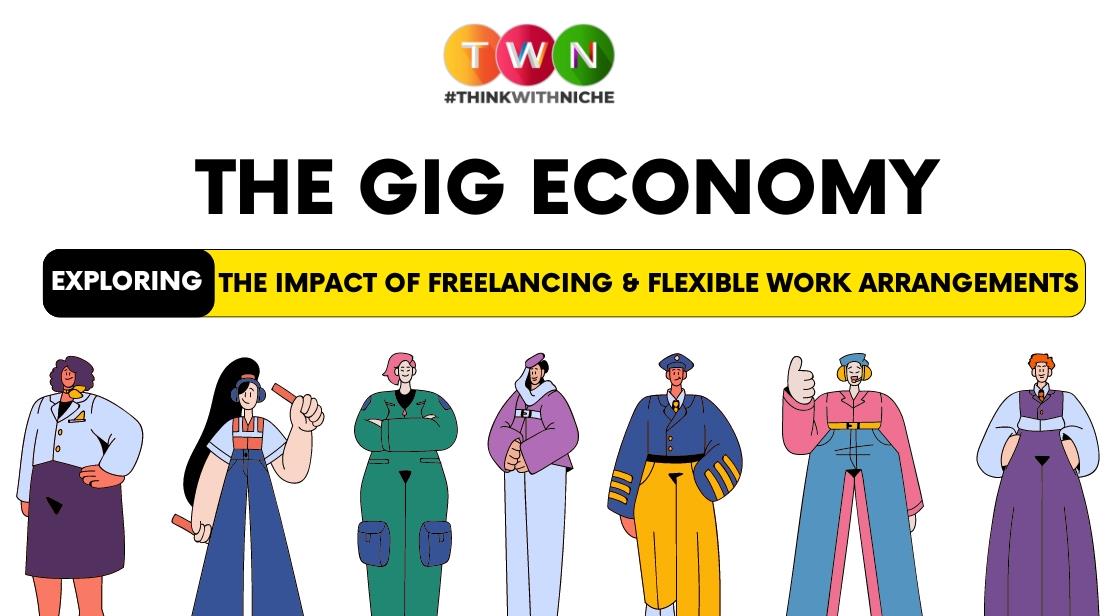The Gig Economy: Exploring the Impact of Freelancing and Flexible Work Arrangements

Blog Post
The emergence of the gig economy has transformed the traditional landscape of employment, ushering in an era characterized by freelancing and flexible work arrangements.
In this dynamic paradigm, individuals are increasingly opting for non-traditional employment opportunities, embracing the freedom and autonomy afforded by freelance work.
From independent contractors to temporary workers, gig workers span diverse sectors, from technology and creative industries to transportation and hospitality.
This shift towards freelancing and flexible work arrangements has significant implications for both workers and industries alike. For workers, the gig economy offers unparalleled flexibility, allowing individuals to dictate their own schedules, pursue multiple income streams, and work remotely.
However, this newfound freedom also comes with its own set of challenges, including income instability, lack of employment benefits, and navigating the complexities of self-employment.
Simultaneously, industries are grappling with the impact of this paradigm shift, as traditional employment models are increasingly being supplanted by agile and contingent workforce structures.
Companies are leveraging gig workers to access specialized skills on-demand, scale operations efficiently, and adapt to rapidly changing market demands. Yet, this transition presents its own set of dilemmas, including questions surrounding labor rights, regulatory frameworks, and the long-term sustainability of gig-based business models.
Against this backdrop, it becomes imperative to delve deeper into the intricacies of the gig economy, exploring its multifaceted impact on individuals, businesses, and society at large.
By examining the opportunities and challenges inherent in freelancing and flexible work arrangements, we can better understand the forces driving this transformational shift and chart a course towards a more equitable and sustainable future of work.
Unveiling the Gig Economy: Freelancing in Today's Economy
Introduction to the Gig Economy
The gig economy refers to a labor market characterized by short-term contracts, freelance work, and independent contractors rather than traditional full-time employment.
In this digital age, technology platforms facilitate connections between individuals offering services (gig workers) and those seeking them (clients or customers). The gig economy has rapidly expanded in recent years, fueled by advances in technology, changing work preferences, and economic shifts.
The Gig Economy, also known as the freelance economy or the sharing economy, refers to a work environment where short-term contracts and independent work arrangements are increasingly common.
Here's a breakdown of the key points:
- Focus on Projects vs. Permanent Jobs: People don't hold traditional full-time jobs with a single employer. Instead, they work on specific projects or tasks for different companies or clients.
- Independent Workers: Individuals in the gig economy are typically considered independent contractors or freelancers. This means they are responsible for finding their own work, managing their schedules, and paying their own taxes.
- Digital Platforms: Many gig economy jobs are facilitated by online platforms that connect workers with clients. These platforms can be for a variety of services, including:
- Transportation (e.g., Uber, Lyft)
- Delivery (e.g., DoorDash, Swiggy, Zomato)
- Microtasks (e.g., Amazon Mechanical Turk)
- Professional services (e.g., Upwork, Fiverr)
- Content creation (e.g., Freelancer.com)
1. Rise of Freelancing: Trends and Statistics
Freelancing has become increasingly prevalent, with millions of individuals worldwide opting for flexible work arrangements.
-
Growing Trend: Freelancing is on the rise globally, with millions of individuals opting for flexible work arrangements rather than traditional employment.
-
Economic Impact: Recent studies indicate that freelancers play a significant role in the global economy, contributing substantially to various sectors.
-
Increasing Numbers: The number of gig workers, or freelancers, continues to climb steadily, reflecting a shift in how people choose to work.
-
Motivating Factors: Several factors are driving this trend, including the desire for autonomy and independence in one's work life. Freelancers appreciate the flexibility to set their schedules and choose their projects.
-
Work-Life Balance: Another significant driver is the pursuit of a better work-life balance. Freelancers have the flexibility to structure their work around personal commitments, leading to higher satisfaction levels.
-
Diversified Income Streams: Freelancing offers the opportunity to pursue multiple income streams simultaneously. This diversity can provide financial stability and resilience in an unpredictable job market.
-
Industry Diversity: Freelancing encompasses a wide range of industries, including technology, creative services, consulting, and more. This diversity of opportunities allows individuals from various backgrounds to find freelance work suited to their skills and expertise.
-
Technological Advancements: Advancements in technology have facilitated the rise of freelancing platforms, making it easier for freelancers to connect with clients and manage their projects remotely.
-
Global Accessibility: The internet has made freelancing accessible on a global scale, enabling individuals to work with clients from different countries and cultures. This globalization of freelancing opens up new opportunities and markets for skilled workers.
2. Benefits and Challenges of Freelancing
Freelancing offers several advantages, such as flexibility, autonomy, and the ability to control one's schedule. Gig workers have the freedom to choose their projects, clients, and work locations, which can lead to greater job satisfaction.
Benefits of Freelancing:
-
Flexibility: Freelancers have the freedom to set their own schedules, allowing them to work at times that suit them best.
-
Autonomy: They can choose the projects they want to work on and the clients they want to work with, giving them a sense of control over their career.
-
Variety of Work: Freelancers can diversify their portfolio by taking on a variety of projects in different industries, keeping their work interesting and challenging.
-
Skill Development: Constant exposure to new projects provides freelancers with opportunities to expand their skill set and expertise.
-
Networking: Engaging with various clients and collaborators allows freelancers to build a broad professional network, opening doors to future opportunities.
-
Earning Potential: Freelancers often have the potential to earn more than traditional employees, as they can set their own rates and take on multiple projects simultaneously.
Challenges of Freelancing:
-
Income Instability: Freelancers may experience fluctuating income due to irregular project timelines and payment schedules.
-
Unpredictable Workloads: Work volume can vary greatly, leading to periods of high demand followed by lulls in work availability.
-
Lack of Benefits: Freelancers typically do not receive benefits such as healthcare, retirement plans, or paid time off, which can impact financial security and well-being.
-
Financial Management: Freelancers are responsible for managing their own finances, including budgeting, invoicing, and tax obligations, which requires discipline and financial literacy.
-
Client Relationships: Maintaining positive relationships with clients is crucial for securing future work, but it can also be challenging to navigate communication and expectations independently.
-
Isolation: Working alone for extended periods can lead to feelings of isolation and loneliness, especially for freelancers who primarily work from home.
Also Read: Best Tools and Resources for Freelancers to Work Efficiently
3. Flexible Work Arrangements: Remote Work and Telecommuting
The rise of technology has enabled remote work and telecommuting, allowing individuals to perform their job duties from virtually anywhere with an internet connection. Remote work offers benefits for both employers and employees, including cost savings, increased productivity, and improved work-life balance.
Many companies have adopted flexible work policies, allowing employees to choose when and where they work, leading to higher job satisfaction and retention rates.
Technology Empowerment:
-
Advancements in technology have facilitated remote work and telecommuting.
-
With internet connectivity, individuals can execute job tasks from any location.
Mutual Benefits:
-
Remote work presents advantages for both employers and employees.
-
Employers benefit from reduced overhead costs, including office space and utilities.
-
Employees experience heightened productivity and a better work-life balance.
Cost Savings:
-
Remote work reduces the need for physical office space, saving on rent and maintenance expenses.
-
Employees save on commuting costs, such as fuel or public transportation fares.
Enhanced Productivity:
-
Remote work often results in increased productivity due to fewer distractions and more autonomy.
-
Employees can tailor their work environment to suit their preferences, leading to better focus and efficiency.
Improved Work-Life Balance:
-
Telecommuting allows employees to better integrate work with personal responsibilities.
-
Flexibility in work hours enables individuals to schedule tasks around family commitments or personal interests.
Job Satisfaction and Retention:
-
Flexible work policies contribute to higher levels of job satisfaction among employees.
-
Companies that offer remote work options tend to experience improved retention rates, as employees value the flexibility and autonomy provided.
Adoption of Flexible Work Policies:
-
Many organizations have embraced flexible work arrangements in response to changing workforce preferences and technological capabilities.
-
Flexible work policies empower employees to choose when and where they work, fostering a culture of trust and autonomy within the organization.
Future Outlook:
-
The trend towards remote work and telecommuting is expected to continue as technology evolves and societal norms adapt.
-
Companies that prioritize flexible work arrangements are likely to attract top talent and remain competitive in a dynamic business landscape.
4. Gig Workers' Rights and Protections
Gig workers often lack the same rights and protections afforded to traditional employees. As independent contractors, they may not receive benefits such as healthcare, paid leave, or unemployment insurance. Additionally, gig workers may face challenges related to job security, discrimination, and fair compensation.
Lack of Traditional Employment Benefits:
-
Gig workers, classified as independent contractors, often miss out on standard benefits like healthcare, paid leave, and unemployment insurance.
-
Absence of these benefits leaves gig workers vulnerable in times of illness, injury, or economic downturns, impacting their financial stability and well-being.
Challenges in Job Security and Fair Compensation:
-
Gig workers face uncertainties regarding the continuity of work and income stability due to the nature of short-term contracts or project-based assignments.
-
Compensation may not always be equitable, with gig workers sometimes experiencing lower pay rates compared to traditional employees for similar tasks.
Discrimination and Fair Treatment:
-
Discrimination based on various factors such as race, gender, or age can occur within the gig economy, affecting opportunities and treatment for workers.
-
Lack of clear channels for addressing grievances or seeking recourse against unfair treatment exacerbates the vulnerability of gig workers to discrimination.
Advocacy Efforts and Legislative Solutions:
-
Ongoing advocacy seeks to raise awareness about the challenges faced by gig workers and push for improved rights and protections.
-
Some jurisdictions have enacted legislation to extend labor protections to gig workers, aiming to address gaps in their legal status and ensure fair treatment.
Innovative Approaches to Support Gig Workers:
-
Portable benefits initiatives are being explored to provide gig workers with access to benefits that are not tied to a single employer, offering flexibility and security.
-
Collective bargaining agreements are being considered as a means for gig workers to negotiate terms and conditions collectively, strengthening their bargaining power and ability to advocate for fair treatment.
Continuing Dialogue and Evolution:
-
The conversation around gig workers' rights is ongoing, with stakeholders engaging in dialogue to find sustainable solutions that balance flexibility for workers and fair treatment.
-
Continued monitoring of the evolving gig economy landscape is essential to adapt regulations and policies to meet the changing needs and challenges faced by gig workers.
Also Read: What is Social Listening and Why is it Important?
5. Impact of the Gig Economy on Traditional Employment
The gig economy has had a profound impact on traditional employment patterns. Many industries have seen a rise in contingent workers, freelancers, and independent contractors, leading to a shift away from traditional full-time employment models. Some companies are restructuring their workforce to leverage gig workers for specific projects or tasks, while others are outsourcing non-core functions to freelance professionals.
Rise of Non-Traditional Work Arrangements:
-
Traditional full-time employment models are being supplanted by flexible work arrangements.
-
Contingent workers, freelancers, and independent contractors are in demand due to their adaptability and specialized skill sets.
-
This trend is particularly evident in sectors such as technology, creative industries, and professional services.
Workforce Restructuring:
-
Companies are restructuring their workforce to capitalize on the benefits of gig workers.
-
Rather than hiring full-time employees, businesses are opting for project-based or task-specific engagements with freelancers.
-
This allows companies to access a diverse talent pool and scale their workforce based on project requirements.
Outsourcing Non-Core Functions:
-
Many organizations are outsourcing non-core functions to freelance professionals.
-
Tasks such as graphic design, content writing, and administrative support are frequently delegated to freelancers, enabling companies to focus on their core competencies.
-
Outsourcing reduces overhead costs associated with maintaining in-house staff and provides access to specialized expertise on an as-needed basis.
Impact on Traditional Employment Stability:
-
The proliferation of gig workers has raised concerns about job security and stability for traditional employees.
-
With companies favoring flexible arrangements, traditional employees may face increased competition for fewer full-time positions.
-
This shift towards contingent work may also lead to a lack of benefits and protections traditionally associated with full-time employment.
6. Gig Economy Platforms and Marketplaces
Technology platforms and online marketplaces play a crucial role in the gig economy, connecting gig workers with potential clients or customers. These platforms provide a digital infrastructure for freelancers to showcase their skills, find work opportunities, and manage their business operations.
Examples include freelance platforms like Upwork, Fiverr, and Freelancer, as well as gig economy apps like Uber, Lyft, and TaskRabbit.
Freelance Platforms:
-
Examples: Upwork, Fiverr, Freelancer.
-
Functionality: Provide a virtual space for freelancers to create profiles, showcase portfolios, and bid on projects posted by clients.
-
Benefits: Offer a wide range of job categories, allowing freelancers to find work aligned with their expertise. Additionally, they facilitate secure payment transactions and provide tools for project management and communication.
Gig Economy Apps:
-
Examples: Uber, Lyft, TaskRabbit.
-
Functionality: Connect gig workers with individuals or businesses in need of specific services, such as transportation, household tasks, or errands.
-
Benefits: Enable gig workers to easily access available gigs, manage their schedules, and receive payments through integrated platforms. They also prioritize user safety through features like background checks and ratings/reviews systems.
Digital Infrastructure:
-
These platforms establish a robust digital infrastructure that streamlines the gig economy ecosystem.
-
Features such as search filters, messaging systems, and rating mechanisms enhance the efficiency and trustworthiness of transactions.
-
The convenience of accessing work opportunities and managing freelance careers online has significantly contributed to the growth and sustainability of the gig economy.
7. Future Trends and Predictions for the Gig Economy
The gig economy is expected to continue growing and evolving in the coming years. Technological advancements, demographic shifts, and changing consumer preferences will shape the future of work.
Trends such as the rise of the "digital nomad," increased demand for remote work options, and the emergence of new gig economy sectors are likely to influence the landscape. Additionally, ongoing debates about labor rights, regulatory frameworks, and the gig economy's impact on society will shape future policy decisions and industry practices.
Continued Growth and Evolution:
-
The gig economy is poised to expand further, driven by factors like technological advancements, demographic changes, and evolving consumer behavior.
-
As technology becomes more integrated into daily life, platforms facilitating gig work will likely proliferate, catering to a wider array of services and industries.
Rise of the "Digital Nomad":
-
With the increasing acceptance of remote work and the availability of digital tools for communication and collaboration, the concept of the digital nomad will become more mainstream.
-
Individuals will have the freedom to work from anywhere, leading to a surge in location-independent freelancers and remote workers.
Demand for Remote Work Options:
-
The COVID-19 pandemic accelerated the adoption of remote work, and this trend is expected to persist post-pandemic.
-
Employers and gig workers alike will prioritize flexibility and remote work options, leading to a greater reliance on virtual platforms for project management and communication.
Emergence of New Gig Economy Sectors:
-
Traditional gig sectors such as transportation and hospitality will continue to thrive, but new niches will also emerge.
-
Industries like healthcare, education, and professional services will witness an increase in gig opportunities as technology enables remote service delivery and on-demand expertise.
Debates on Labor Rights and Regulation:
-
The gig economy will remain a subject of contentious debates regarding labor rights, worker protections, and regulatory oversight.
-
Policymakers will grapple with finding a balance between fostering innovation and ensuring fair treatment and security for gig workers, leading to potential shifts in regulatory frameworks and industry practices.
8. Policy and Regulatory Considerations for Gig Workers
As the gig economy continues to expand, policymakers face the challenge of ensuring that gig workers are adequately protected and supported. Key policy considerations include labor rights, worker classification, benefits eligibility, and tax regulations.
Policymakers must strike a balance between fostering innovation and protecting the rights and well-being of gig workers. Collaborative efforts between governments, industry stakeholders, and labor organizations are essential to address the complex issues surrounding the gig economy.
Labor Rights Protection:
-
Ensure gig workers have access to basic labor rights such as fair wages, safe working conditions, and protection against discrimination and harassment.
-
Develop mechanisms for resolving disputes between gig workers and platform companies regarding working conditions and pay.
Worker Classification:
-
Determine appropriate classification for gig workers (e.g., independent contractors vs. employees) to ensure they receive appropriate legal protections and benefits.
-
Clarify guidelines for companies to classify workers accurately, avoiding misclassification that may lead to exploitation or denial of benefits.
Benefits Eligibility:
-
Explore options for extending traditional employment benefits such as healthcare, retirement savings, and paid leave to gig workers.
-
Develop portable benefits models that allow gig workers to accumulate benefits across multiple platforms or jobs.
Tax Regulations:
-
Establish clear tax regulations for gig workers and platforms to ensure compliance and fair contribution to public services.
-
Consider tax incentives or deductions to support gig workers, such as deductions for business expenses or simplified tax filing processes.
Balancing Innovation and Protection:
-
Foster innovation in the gig economy while safeguarding the rights and well-being of workers.
-
Encourage experimentation with new business models and technologies while implementing safeguards to prevent exploitation and abuse.
Collaborative Efforts:
-
Facilitate collaboration among governments, industry stakeholders, and labor organizations to address the complex challenges of the gig economy.
-
Create platforms for dialogue and negotiation to develop comprehensive and adaptable regulatory frameworks.
9. Strategies for Success in the Gig Economy
Gig workers can enhance their success by adopting various strategies and best practices. These may include:
Building a Strong Online Presence and Professional Brand:
-
Establishing a robust online presence through platforms like LinkedIn, personal websites, or professional social media accounts.
-
Showcasing skills, experiences, and past projects to attract potential clients or customers.
-
Consistently engaging with online communities related to their field to stay visible and build credibility.
Networking and Relationship Building:
-
Actively networking with clients, customers, and fellow gig workers through social events, online forums, and industry meetups.
-
Cultivating strong relationships with existing clients to encourage repeat business and referrals.
-
Leveraging connections to uncover new opportunities and expand their professional network.
Diversifying Income Streams:
-
Pursuing multiple gigs or projects simultaneously to reduce reliance on any single source of income.
-
Exploring different platforms or marketplaces to access a broader range of opportunities.
-
Considering alternative revenue streams such as affiliate marketing, consulting, or teaching to supplement primary income sources.
Investing in Skills Development:
-
Continuously upgrading skills through online courses, workshops, or certifications to remain competitive.
-
Staying informed about industry trends, technological advancements, and emerging best practices.
-
Adapting to evolving demands by learning new tools, software, or techniques relevant to their niche.
Effective Financial Management:
-
Budgeting and tracking expenses to ensure stable finances during fluctuations in income.
-
Setting aside savings for emergencies or periods of low work availability.
-
Exploring insurance options or retirement plans tailored for self-employed individuals.
Advocating for Fair Treatment:
-
Negotiating fair compensation rates and contractual terms with clients or platforms.
-
Advocating for policies that promote fair treatment, transparency, and accountability within the gig economy.
-
Seeking legal or regulatory support in cases of dispute or exploitation.
Seeking Support and Mentorship:
-
Joining professional associations or online communities to access resources, mentorship, and support networks.
-
Seeking guidance from experienced mentors or coaches to navigate challenges and make informed decisions.
-
Participating in peer support groups or mentorship programs to share experiences and exchange advice.
Prioritizing Work-Life Balance and Self-Care:
-
Establishing clear boundaries between work and personal life to prevent burnout and maintain well-being.
-
Allocating time for leisure activities, hobbies, and self-care practices to recharge and stay motivated.
-
Recognizing the importance of mental and physical health in sustaining long-term success in the gig economy.
Conclusion
In conclusion, the gig economy presents both opportunities and challenges for workers, businesses, and policymakers. As the nature of work continues to evolve, it is essential to recognize the significance of freelancing and flexible work arrangements in today's economy.
By understanding the trends, benefits, challenges, and policy implications of the gig economy, stakeholders can work towards creating a more inclusive
You May Like
EDITOR’S CHOICE












